호흡곤란 Breathing difficulty(Difficulty breathing)

그림 4. 상기도와 하기도
기도를 편의상 상기도와 하기도로 분류한다.
Copyright ⓒ 2011 John Sangwon Lee, MD., FAAP
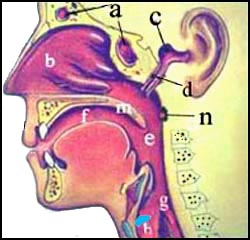
그림 2. 상기도
a-전두동, b-비강, c-중이강, d-이관(구씨관), e-인두, f-구강, g-식도, h-기관, m-연구개, n-아데노이드, o-접형동.
Copyright ⓒ 2011 John Sangwon Lee, MD., FAAP
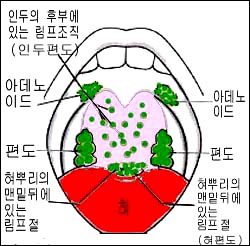
그림 3. 인두와 인두 주위에 있는 림프 조직들
인두 주위에는 아데노이드, 편도, 혀뿌리 부위에 있는 설편도(혀 편도)와 인두강 후벽에 인두 편도 등의 림프 조직이 있다. (파란색 부분으로 표시됐다.)
이들은 비강과 구강을 통해 들어오는 항원, 해로운 이물질과 세균 등을 잡는 방어기능을 한다.
Copyright ⓒ 2011 John Sangwon Lee, MD., FAAP
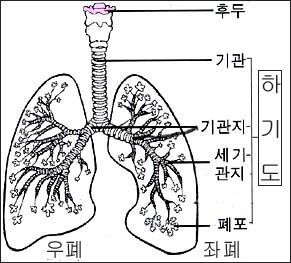
그림 5. 하기도와 폐.
Copyrightⓒ 2011 John Sangwon Lee, MD., FAAP
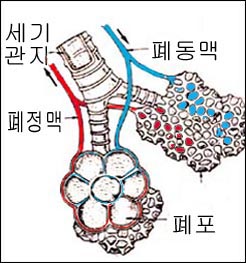
그림 6. 폐포와 모세기관지(세기관지).
Copyrightⓒ 2011 John Sangwon Lee, MD., FAAP
- 숨을 정상 이상으로 어렵게 쉬는 증상징후를 호흡곤란이라 한다.
- 호흡곤란을 “숨이 가쁘다”, “숨 쉬기가 어렵다” 등으로도 표현한다.
- 호흡곤란은 어떤 병의 증상 징후이지 병명은 아니다.
- 그래서 호흡이 곤란하면 호흡 곤란의 원인이 무엇인지 알아보고 그에 따라 치료 한다.
- 호흡곤란의 정도에 따라,
-
- 경도 호흡곤란,
- 중등도 호흡곤란,
- 중증 호흡곤란으로 나눌 수 있다.
- 구체적으로 다음 더 설명하면,
경도 호흡곤란
- 숨 쉴 때 본인에게 호흡곤란 증상징후가 있는지 모를 정도로 숨을 어렵게 쉬기도 하고,
- 숨쉬기 어렵다는 것을 본인이 느낄 수 있게 어렵게 숨을 쉴 때도 있다.
- 이런 정도 호흡곤란을 경도 호흡곤란이라고 한다.
중등도 호흡곤란
- 경도 호흡곤란이 있을 때 중증도보다 더 심하고 중증 호흡곤란의 중증도보다 조금 덜 심한 호흡곤란을 중등도 호흡곤란이라고 한다.
-
- 상당히 힘들고 어렵게 숨을 쉬면서 얼굴이 창백하고,
- 숨 쉴 때마다 콧날개(비익, 사진 281참조)가 벌렁벌렁거리고,
-
- 늑골(갈비뼈) 사이에 있는 늑골 근육이 흉곽강 속 쪽으로 딸려 들어갔다 흉곽의 바깥쪽으로 도로 나왔다 하면서 숨을 쉴 때마다 두 어깨가 머리가 있는 위쪽으로 올라갔다 다리가 있는 아래쪽으로 내려갔다 할 수 있고,
- 숨이 금방 넘어갈 듯이 아주 어렵게 쉬어
- 옆에 있는 사람이 그 환아에게 호흡곤란이 있다는 것을 쉽게 알 수 있을 정도로 숨을 곤란하게 쉴 수 있다.
이런 정도 호흡곤란은 중증도 호흡곤란이라고 한다.
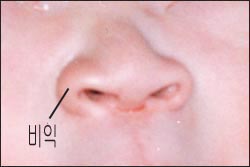
사진 281. 갓 태어난 신생아의 정상 코
중증 호흡곤란
- 중등도 호흡곤란 내지 중증 호흡곤란이 있으면
-
- 안절부절 못하고
- 숨결이 빠르고,
- 숨을 깊게, 또는 얕게 쉬고,
- 상당히 힘들게 숨 쉬면서
- 괴로워 할 수 있다.
- 때로는 숨을 내쉴 때마다 가랑가랑 숨소리를 내거나 쌕쌕거리는 천명을 낼 수도 있고
- 숨을 들이 쉴 때 협착음(Stridor)을 낼 수도 있다.
- 중증 호흡곤란이 있을 때 치료를 즉시 적절히 해주지 않으면 생명이 위험할 수 있다.
호흡곤란의 원인
- 호흡곤란의 원인은 많다.
- 비강, 인두, 후두, 기관, 기관지 등 상·하기도 속에 있는 이물로 기도의 일부 또는 상당 부분이 막히거나, 정상적 호흡을 하는데 관련되어 있는 폐, 심장, 횡격막, 신경, 근육 등에 생긴 어떤 병이나 이상이 있을 때 호흡곤란이 생길 수 있다.
원인에 따른 호흡곤란의 증상 징후
- 입에 물고 놀던 장난감, 먹던 음식물, 또는 구토 물 등이 인두강, 후두강, 기관 속, 또는 기관지 속으로 갑자기 들어가서 기도 내 이물이 될 수 있다. 그 기도 내 이물로 인해 기도가 완전히 막힐 수도 있고, 부분적으로 막힐 수 있다.
- 이때 호흡곤란이 경도 내지 중등도 또 중증으로 심하게 생길 수 있고 중증도가 심하면 사망도 할 수 있다.
- 갓 태어난 신생아의 비강 후부(후비공)의 한쪽이나 양쪽이 선천적으로 완전히 막힐 수 있고, 일부가 선천적으로 막힐 수 있다. 이런 선천성 코 기형을 선천성 후 비공 폐쇄증이라고 한다. 이런 선천성 후비공 기형을 갖고 태어난 신생아에게 호흡곤란이 심하게 생길 수 있다. 선천성 후 비공 폐쇄증이 비강의 후부에 있는 후비공에 있을 때는 호흡곤란이 아주 심하게 생길 수 있고 중추성 청색증이 나타날 수 있다.
- 감기나 다른 종류의 상기도 감염병을 앓을 때 비강 속 기도의 일부나 대부분이 완전히, 또는 일부가 일시적으로 막힐 때 호흡곤란이 생길 수 있다.
- 특히 신생아들이나 생후 1~3개월 된 영아들이 감기에 걸리면 호흡곤란이 더 심하게 생길 수도 있다(신생아 감기 참조).
- 후두 종양, 선천성 후두천명, 바이러스 후두염이나 크루프, 급성 박테리아 후두개염 등으로 호흡곤란이 생길 수 있다.
- 심장 비대나, 기관이나 기관지의 근방에 난 종양 등으로 기관, 기관지, 또는 폐 등 호흡기가 눌릴 때 기도 속이 좁아져 호흡곤란이 생길 수 있다.
- 기관지 천식, 폐렴, 또는 세기관지염(모세기관지염) 등 호흡기 질병으로 호흡곤란이 생길 수 있다.
- 알레르기 비염으로 비강 점막층이 붓고 비강이 막힐 때 호흡곤란이 생길 수 있다.
- 기흉, 무기폐, 심장병, 정신병 등으로 호흡곤란이 생길 수 있다.
- 그 외 다른 원인으로도 호흡곤란이 생길 수 있다.
- 종합하면, 기도 내 이물, 급성 박테리아 후두개염, 급성 바이러스 후두염, 심한 기관지 천식, 급성 세기관지염, 급성 폐렴 등으로 소아청소년(0~18세)들에게 호흡곤란이 생길 수 있다.
호흡곤란의 응급처치와 치료
- 호흡곤란의 중증도와 원인 등에 따라 응급치료 한다.
- 대개, 소아청소년 자녀들에게 호흡 곤란이 생기면 1차적으로 부모가 응급 처치를 우선 하고 필요에 따라 추적치료를 하게 된다.
- 숨이 많이 차고 아주 어렵게 숨을 쉬든지 거의 숨을 쉬지 못하면 현장에서 응급처치를 바로 시작해야 할 때가 많다.
- 필요에 따라 주위 사람들의 도움을 긴급히 청해서 서로 협력해 치료해야 한다.
- 그와 동시 의료 구급대원이나, 병원 응급실이나 단골 소아청소년 의사에게 응급으로 전화해 그들의 지시에 따라 응급 치료를 현장에서 바로 시작한다.
- 호흡곤란이 상당히 심하고 의식이 있는 경우, 다른 사람의 도움을 받을 수 없으면 적절한 교통수단으로 병원 응급실로 급히 데리고 가야 할 때도 있다.
- 인두강 속에 이물이 있다고 의심되고 의식이 있고 경미한 호흡곤란이 있을 때 의료 구급대원이나 단골 소아청소년 의사나 병원 응급실에 전화해 응급으로 그들의 지시에 따라 현장에서 응급 치료를 시작한다.
- 인두강 속에 있는 이물이 쉽게 보이고 숨을 잘 쉴 수 있고 손가락 등으로 이물을 쉽게 꺼낼 수 있으면 손가락 등으로 이물을 꺼낼 수 있다.
- 인두 이물을 손가락으로 꺼내려고 시도할 때 인두강 속 이물이 인두강 기도 부분 속 더 깊숙이 또는 후두가 있는 인두 기도 부분 속 쪽으로 더 깊이 들어갈 수 있고 그로 인해 후두가 완전히 막혀 질식할 수 있다.
- 이물이 인두강 속에 깊숙이 있고, 숨쉬기가 곤란할 때 이물을 손가락으로 후벼서 꺼내기가 힘들 때도 있다.
- 환아를 안정시키면서 의료 구급대원이나, 의사나 병원 응급실에 응급으로 전화해 그들의 전화 응급치료에 따라 구급차나 다른 적절한 교통수단으로 병원 응급실로 급히 이송한다.
Breathing difficulty (Difficulty breathing)

Figure 4. Upper and lower airways Airways are classified into upper and lower airways for convenience. Copyright ⓒ 2011 John Sangwon Lee, MD., FAAP

Figure 2. Upper airway a – frontal sinus, b – nasal cavity, c – middle ear cavity, d – ear canal (bulb canal), e – pharynx, f – oral cavity, g – esophagus, h – trachea, m – soft palate, n – adenoid, o – sphenoid sinus. Copyright ⓒ 2011 John Sangwon Lee, MD., FAAP

Figure 3. The pharynx and lymphoid tissues around the pharynx Around the pharynx, there are lymphoid tissues such as adenoids, tonsils, lingual tonsils (tongue tonsils) located at the root of the tongue, and pharyngeal tonsils on the posterior wall of the pharynx. (Indicated in blue.) They have a defensive function of catching antigens, harmful foreign substances, and bacteria that enter through the nasal passages and oral cavity. Copyright ⓒ 2011 John Sangwon Lee, MD., FAAP

Figure 5. Lower respiratory tract and lungs. Copyrightⓒ 2011 John Sangwon Lee, MD., FAAP

Figure 6. Alveoli and capillaries (bronchioles). Copyrightⓒ 2011 John Sangwon Lee, MD., FAAP
• Dyspnea is a symptom that makes breathing more difficult than normal. • Shortness of breath is also expressed as “suffering” or “difficulty breathing”.
• Dyspnea is a symptom of a disease, not a disease name.
• So, if you have trouble breathing, find out what the cause of the trouble is and treat it accordingly.
• Depending on the severity of the shortness of breath,
o Mild dyspnea,
o Moderate dyspnea,
o It can be classified as severe dyspnea.
• More specifically, the following
Mild dyspnea
• When breathing, I have difficulty breathing so much that I don’t even know if I have symptoms of shortness of breath;
• Sometimes it is difficult to breathe so that you can feel that it is difficult to breathe.
• Shortness of breath of this degree is called mild dyspnea.
Moderate dyspnea
• When mild dyspnea is present, dyspnea that is more severe than moderate and slightly less severe than the severity of severe dyspnea is called moderate dyspnea.
• o pale face with very difficult and difficult breathing,
o Nostrils (fly, see photo 281) flapping with each breath,
• o The rib muscles between the ribs (ribs) are attached to the inside of the thoracic cavity and come back out of the rib cage, so that with each breath, both shoulders go up with the head and go down with the legs,
o Breathe very hard as if you are out of breath o I can breathe so hard that the person next to me can easily recognize that the child is having trouble breathing.
Shortness of breath of this degree is called severe dyspnea.

Photo 281. Normal nose of a newborn baby If the right wing (nostrils), newborns have pneumonia or have respiratory problems, breathing difficulties may occur, and both nostrils may flap with every breath. Copyright ⓒ 2011 John Sangwon Lee, MD., FAAP
Severe shortness of breath
• If you have moderate to severe dyspnea
• o restless o breathing quickly, o Breathe deeply or shallowly,
o breathing quite hard
o Can be distressing.
o Occasionally you may have a wheezing or wheezing wheeze with every exhalation
o Stridor may be produced when breathing in.
• Severe shortness of breath can be life threatening if not treated promptly and appropriately.
Causes of shortness of breath
• There are many causes of shortness of breath.
• Any disease or abnormality in the lungs, heart, diaphragm, nerves, muscles, etc. that is related to breathing normally or blocking part or a large part of the airway with a foreign body in the upper and lower respiratory tract such as the nasal cavity, pharynx, larynx, trachea, and bronchi.
This may cause shortness of breath.
Symptoms, signs of dyspnea by cause
• Toys you put in your mouth, food you eat, or vomit can suddenly enter the pharynx, larynx, trachea, or bronchi and become foreign bodies in the airways. A foreign object in the airway may block the airway completely, or it may partially block it.
• At this time, dyspnea may occur in mild to moderate or severe severity, and death may occur if the severity is severe.
‘• One or both of the posterior nasal passages (posterior nostrils) in newborns may be completely blocked congenitally, and some may be congenitally blocked. This congenital anomaly of the nose is called congenital post-nasal atresia. Newborns born with these congenital anomalies can cause severe respiratory distress. When congenital post-nasal atresia is in the posterior nostril of the nasal cavity, dyspnea can occur very seriously and central cyanosis can appear.
• When you have a cold or other upper respiratory tract infection, you may have difficulty breathing when part or most of the nasal airways are completely or temporarily blocked.
• Shortness of breath may be more severe, especially in newborns or infants 1 to 3 months old, when they catch a cold (see Newborn Colds).
• Laryngeal tumors, congenital laryngeal wheezing, viral laryngitis or croup, and acute bacterial epiglottitis can cause breathing difficulties.
• When the respiratory tract, such as the trachea, bronchi, or lungs is compressed due to an enlarged heart or a tumor in the vicinity of the trachea or bronchi, breathing difficulties may occur due to the narrowing of the airway.
• Respiratory problems such as bronchial asthma, pneumonia, or bronchiolitis (bronchiolitis) can cause shortness of breath.
• Allergic rhinitis can cause breathing difficulties when the nasal mucosa swells and the nasal passages become blocked
• Shortness of breath may occur due to pneumothorax, atelectasis, heart disease, or mental illness.
• Other causes can also cause shortness of breath.
• In summary, respiratory difficulties can occur in children and adolescents (0~18 years of age) due to foreign bodies in the airways, acute bacterial epiglottitis, acute viral laryngitis, severe bronchial asthma, acute bronchiolitis, and acute pneumonia.
First aid and treatment of dyspnea
• Provide emergency treatment according to the severity and cause of dyspnea.
• In general, when children and adolescents develop breathing difficulties, the parents give priority to first aid and follow-up treatment if necessary.
1. If you are out of breath and breathing very hard or barely breathing, it is often necessary to immediately start first aid at the scene.
2. If necessary, urgently seek the help of those around you and cooperate with each other for treatment.
3. At the same time, call emergency medical personnel, hospital emergency room, or regular pediatrician, and start emergency treatment on the spot according to their instructions.
4. If you have severe breathing difficulties and are conscious, you may need to take them to the emergency room of a hospital by appropriate means of transportation if assistance is not available.
5. When you suspect that there is a foreign body in the pharyngeal cavity and you are conscious and have mild breathing difficulties, call a medical paramedic, a regular pediatrician, or the hospital emergency room and start emergency treatment on the spot according to their instructions.
6. If the foreign object in the pharynx can be easily seen and breathed well and the foreign object can be easily removed with a finger, etc., the foreign object can be taken out with a finger, etc.
7. When attempting to withdraw a pharyngeal foreign body with a finger, the pharyngeal foreign body may enter deeper into the pharyngeal airway segment or deeper into the pharyngeal airway segment where the larynx is located, resulting in complete blockage of the larynx and suffocation.
8. When a foreign object is deep in the pharyngeal cavity and it is difficult to breathe, it is sometimes difficult to pull the foreign object out by pulling it out with your fingers.
9. While stabilizing the child, make an emergency call to medical paramedics, doctors, or the hospital emergency room, and take them to the hospital emergency room by ambulance or other suitable means of transportation according to their telephone emergency treatment.
출처 및 참조 문헌 Sources and references
- NelsonTextbook of Pediatrics 22ND Ed
- The Harriet Lane Handbook 22ND Ed
- Growth and development of the children
- Red Book 32nd Ed 2021-2024
- Neonatal Resuscitation, American Academy Pediatrics
-
Pediatric Nutritional Handbook American Academy of Pediatrics
-
소아가정간호백과–부모도 반의사가 되어야 한다, 이상원 저
-
The pregnancy Bible. By Joan stone, MD. Keith Eddleman,MD
-
Neonatology Jeffrey J. Pomerance, C. Joan Richardson
-
Preparation for Birth. Berverly Savage and Dianna Smith
-
임신에서 신생아 돌보기까지. 이상원
-
Breastfeeding by Ruth Lawrence and Robert Lawrence
-
Nelson Textbook of Pediatrics 14th ed. Beherman
- www.drleepediatrics.com 제1권 소아청소년 응급 의료
- www.drleepediatrics.com 제2권 소아청소년 예방
- www.drleepediatrics.com 제3권 소아청소년 성장 발육 육아
- www.drleepediatrics.com 제4권 모유,모유수유, 이유
- www.drleepediatrics.com 제5권 인공영양, 우유, 이유식, 비타민, 미네랄, 단백질, 탄수화물, 지방
- www.drleepediatrics.com 제6권 신생아 성장 발육 육아 질병
- www.drleepediatrics.com제7권 소아청소년 감염병
- www.drleepediatrics.com제8권 소아청소년 호흡기 질환
- www.drleepediatrics.com제9권 소아청소년 소화기 질환
- www.drleepediatrics.com제10권. 소아청소년 신장 비뇨 생식기 질환
- www.drleepediatrics.com제11권. 소아청소년 심장 혈관계 질환
- www.drleepediatrics.com제12권. 소아청소년 신경 정신 질환, 행동 수면 문제
- www.drleepediatrics.com제13권. 소아청소년 혈액, 림프, 종양 질환
- www.drleepediatrics.com제14권. 소아청소년 내분비, 유전, 염색체, 대사, 희귀병
- www.drleepediatrics.com제15권. 소아청소년 알레르기, 자가 면역질환
- www.drleepediatrics.com제16권. 소아청소년 정형외과 질환
- www.drleepediatrics.com제17권. 소아청소년 피부 질환
- www.drleepediatrics.com제18권. 소아청소년 이비인후(귀 코 인두 후두) 질환
- www.drleepediatrics.com제19권. 소아청소년 안과 (눈)질환
- www.drleepediatrics.com 제20권 소아청소년 이 (치아)질환
- www.drleepediatrics.com 제21권 소아청소년 가정 학교 간호
- www.drleepediatrics.com 제22권 아들 딸 이렇게 사랑해 키우세요
- www.drleepediatrics.com 제23권 사춘기 아이들의 성장 발육 질병
- www.drleepediatrics.com 제24권 소아청소년 성교육
- www.drleepediatrics.com 제25권 임신, 분만, 출산, 신생아 돌보기
- Red book 29th-31st edition 2021
- Nelson Text Book of Pediatrics 19th- 21st Edition
- The Johns Hopkins Hospital, The Harriet Lane Handbook, 22nd edition
- 응급환자관리 정담미디어
- Pediatric Nutritional Handbook American Academy of Pediatrics
- 소아가정간호백과–부모도 반의사가 되어야 한다, 이상원 저
- The pregnancy Bible. By Joan stone, MD. Keith Eddleman, MD
- Neonatology Jeffrey J. Pomerance, C. Joan Richardson
- Preparation for Birth. Beverly Savage and Dianna Smith
- 임신에서 신생아 돌보기까지. 이상원
- Breastfeeding. by Ruth Lawrence and Robert Lawrence
- Sources and references on Growth, Development, Cares, and Diseases of Newborn Infants
- Emergency Medical Service for Children, By Ross Lab. May 1989. p.10
- Emergency care, Harvey Grant and Robert Murray
- Emergency Care Transportation of Sick and Injured American Academy of Orthopaedic Surgeons
- Emergency Pediatrics A Guide to Ambulatory Care, Roger M. Barkin, Peter Rosen
- Quick Reference To Pediatric Emergencies, Delmer J. Pascoe, M.D., Moses Grossman, M.D. with 26 contributors
- Neonatal resuscitation Ameican academy of pediatrics
- Pediatric Nutritional Handbook American Academy of Pediatrics
- Pediatric Resuscitation Pediatric Clinics of North America, Stephen M. Schexnayder, M.D.
-
Pediatric Critical Care, Pediatric Clinics of North America, James P. Orlowski, M.D.
-
Preparation for Birth. Beverly Savage and Dianna Smith
-
Infectious disease of children, Saul Krugman, Samuel L Katz, Ann A.
- 제4권 모유, 모유수유, 이유 참조문헌 및 출처
- 제5권 인공영양, 우유, 이유, 비타민, 단백질, 지방 탄수 화물 참조문헌 및 출처
- 제6권 신생아 성장발육 양호 질병 참조문헌 및 출처
- 소아과학 대한교과서
Copyright ⓒ 2014 John Sangwon Lee, MD., FAAP
“부모도 반의사가 되어야 한다”-내용은 여러분들의 의사로부터 얻은 정보와 진료를 대신할 수 없습니다.
“The information contained in this publication should not be used as a substitute for the medical care and advice of your doctor. There may be variations in treatment that your doctor may recommend based on individual facts and circumstances.
“Parental education is the best medicine.